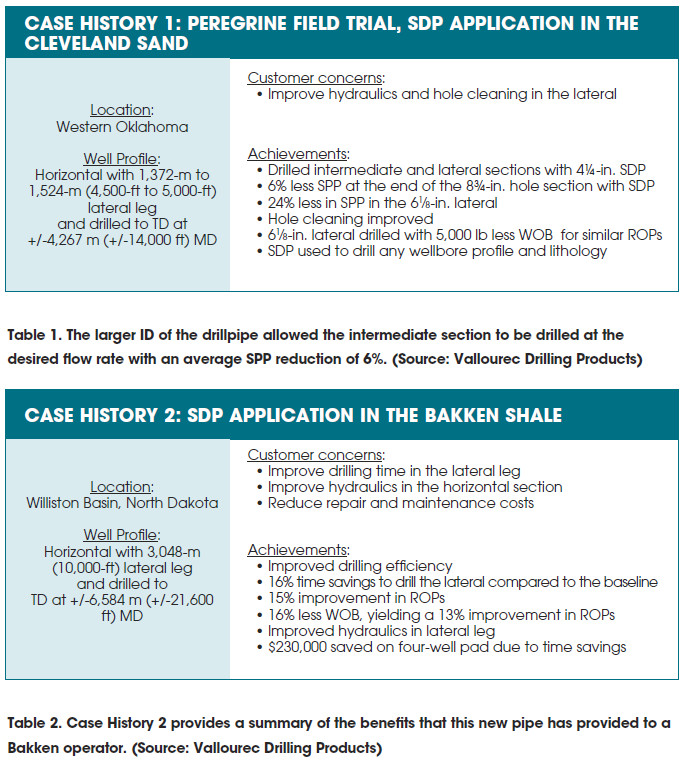The learning curve for the oil and gas industry has been steep and fast—over the last decade operators drilling in North American shale plays have migrated to highly complex and extended-reach wellbore geometries that require tremendous engineering effort. Increasing energy demand has challenged the industry as never before to improve the ROP and drive down
costs in these shale plays without compromising safety.
Drilling longer laterals in wells presents challenges in terms of wellbore hydraulics, borehole cleaning, drillstring buckling, poor weight-on-bit (WOB) transfer and reduced drillpipe service life. Typical symptoms include reduced ROP, difficulty sliding, frequent wiper trips, excessive back-reaming, poor hole quality and severe drillpipe wear along with potential connection damage.
What is Shale Drill Pipe?
Shale Drill Pipe (SDP) is a new 4¼-in. design. The drillpipe body consists of a 4¼-in. outer diameter (OD) tube, 15.4 lb/ft with a wall thickness (WT) of 0.33 in., and is fabricated from S-135 steel as standard material. The SDP tool joint consists of a high-torque tool joint with a 47⁄8-in. OD and a 2-11⁄16-in. inside diameter (ID), manufactured from 130,000-psi material.
Hard-banding is provided flush to the dual OD, and internal plastic coating is a standard feature. The 5¼-in. dual OD is intended to provide improved elevator capacity and additional tube standoff while still allowing it to be fished in a smaller hole size.
The SDP incorporates the VAM Express connection, which has a proprietary thread profile and high-performance single-start double-shoulder design. In fact, it is one of the most rugged and user-friendly high-torque connections available. This thread form has several design features that are meant for easy stabbing and thus improve user friendliness.
Modeling was performed with several software packages to compare 4¼-in. SDP to 4-in., 14-lb/ft (0.33-in. WT) drillpipe in a typical 6,096-m (20,000-ft) horizontal profile Bakken well. The 8½-in. or 8¾-in. section was drilled to 3,048 m (10,000 ft) vertically, then drilled horizontally with a 57⁄8-in. or 6-in. section that extended 3,048 m. Three areas were identified with the most benefits.
Hydraulics improvements:
Hydraulics modeling was performed when drilling the 61⁄8-in. lateral in a typical Bakken well. When comparing 4¼-in. and 4-in.
drillstrings, 30% lower circulating time was required to clean the well. The increased annular velocity allowed the operator to reduce the flow rate, which in turn can allow lower output pumps.
Buckling resistance: The 4¼-in. SDP tube additional stiffness results in a 65% improvement in maximum WOB before lockup when slide-drilling in the 8¾-in. vertical section and a 15% improvement in maximum WOB before helical buckling while rotary-drilling in the 6-in. lateral compared to the standard 4-in. 14-lb/ft drillpipe.
Tube wear reduction: One of the concerns in certain Bakken horizons is pipe body wear, so one of the design goals of the SDP was to reduce tube body wear.
Tube-to-wellbore contact was about 100 lb/sq ft lower with 4¼-in. drillpipe, which amounts to a 40% reduction in side forces.

Peregrine Field trial
For one operator in western Oklahoma the SDP was seen as a solution for overcoming some operational standpipe pressure (SPP) restrictions on the drilling rig. Many wells have been drilled in this area, so these wells provided an excellent opportunity to test the new 4¼-in. drillpipe in a known environment with established metrics to judge well-to-well performance improvements. These wells were drilled with the same mud systems, had similar well profiles and total depth (TD), and targeted the same reservoir.
Three wells were chosen as a baseline for use of standard 4-in. drillpipe, from which Vallourec compared the results of five wells where the operator used the 4¼-in. SDP. When nearing TD in each of these sections, the SPP would frequently approach the limits of the rig’s capabilities, particularly in the lateral. These instances required the flow rate to be decreased, which compromised hole cleaning and ROP.
All five horizontal wells were drilled to TDs of +/-4,389 m (+/-14,400 ft) measured depth (MD) and +/-2,798-m (+/-9,180-ft) true vertical depth with +/-1,372-m (+/-4,500-ft) lateral leg. The larger ID of the drillpipe allowed the intermediate section to be drilled at the desired flow rate of 550 gal/min with an average SPP reduction of 6%. In the lateral section, the pump rate was decreased by 12% while still obtaining the desired annular velocities to sufficiently clean the hole due to the increased OD of the SDP. This resulted in a 24% reduction in SPP at the end of the lateral.
In addition to the Peregrine Field trial, another operator in the Bakken Shale has just successfully finished using the SDP on a four-well pad. Case History 2 provides a summary of the benefits that this new offer has provided to this operator. It is important to note that in the second case history the SDP was compared to an already optimized 4-in. drillpipe, and even higher levels of improvements would have been seen if it was compared against standard 4-in. drillpipe.

Recommended Reading
Enbridge Among Growing List of Earnings Boosted by Acquisitions
2024-11-01 - Enbridge’s utilities acquisitions and gas transport growth helped to drive earnings in the third quarter.
ONEOK’s Acquisitions Pay Off with Increased Earnings
2024-10-31 - ONEOK Inc. also announced the completion of its $2.6 billion Medallion Midstream deal.
PE Firm KKR Buys Stake in Eni’s Biofuels Business for $3.2B
2024-10-24 - KKR will buy nearly a quarter of Eni’s Enilive, which values the biofuels unit at about $12.7 billion.
Report: Colonial Pipeline Considering $10B Sale
2024-10-29 - Colonial owns a 5,500-mile pipeline network which carries more than 100,000 gallons of fuel to an area stretching from Houston to New Jersey.
Diversified Bolts-On Appalachia Gas Production, Midstream Assets
2025-01-06 - Diversified Energy will buy Summit Natural Resources’ assets, including producing wells and coal mine methane wells, in the southern part of the Appalachian Basin.
Comments
Add new comment
This conversation is moderated according to Hart Energy community rules. Please read the rules before joining the discussion. If you’re experiencing any technical problems, please contact our customer care team.





